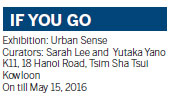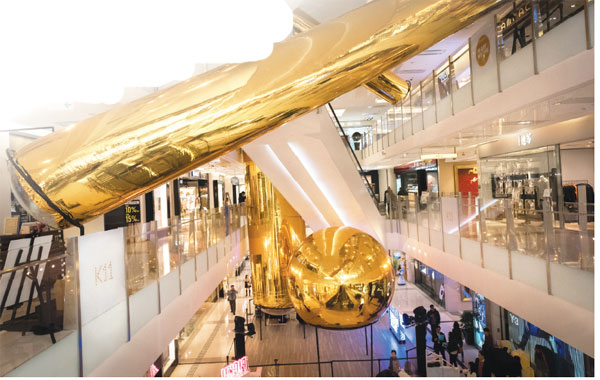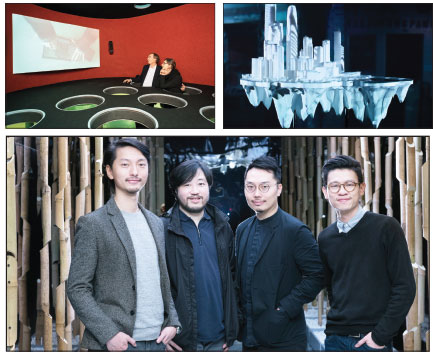Living in a golden bubble
Updated: 2016-04-01 08:09
By Chitralekha Basu(HK Edition)
|
|||||||||
Landscape designers, music composers, photographers and architects come together to explore what connects people with the cities they inhabit at K11. A review by
Chitralekha Basu.
At the first glance, Urban Sense, the exhibition running at the K11 art mall, seems to be all about bulk. A massive set of cylindrical and sphere-shaped balloons placed strategically across the shopping arcade's multiple levels has transformed the interior landscape. The golden PVC balloon skins generate ominously large reflections of the things and people around them.
Another exhibit, called Myriad, comprises an astounding 1,848 music boxes, arranged in rows on facing walls of a corridor, waiting to be wound up and set in motion by the visitors. Created by Topotek 1, a landscape architecture studio in Berlin and the composer Rebecca Saunders, this library of music could cater to several listeners all at once, and that without getting in the way of one another. When activated at random, these numerous strands of pre-recorded music playing simultaneously produce a sound that's surprisingly harmonious.
While the Urban Sense show is indeed somewhat imposing, even overwhelming, rather similar to what one's first brush with a big metropolis often feels like; it is also about experiencing disjunction and fragmentation that's part of life in a modern metropolis. Take the exhibit Cinema Island, for example. The brainchild of architect Colin Fournier and the artist Marysia Lewandowska, Cinema Island is probably the world's tiniest auditorium, which can accommodate about 10 spectators. The audience enters the minuscule theater, mounted on stilts, through circles cut out at the base to watch the film playing inside, even as the lower halves of their bodies, visible to those viewing the installation from the outside, become a part of an ever-mutating showpiece, assuming an altered look and newer dimensions with the slightest change of posture.
The constant shift between the multiple realities created by changing perspectives informs a lot of the artworks on show. James Shen, who created the towering Golden Bubbles installation, meant it to be a comment on the mutability and hollowness of modern urban experience. The shiny surface of his installation piece, he points out, contrasts strongly with what's inside. "The outer surface is gold, reflecting lots of movements. In the interior, all this is on a much smaller scale, just as exaggerated but in a different way. Likewise, you can think of Hong Kong from an exterior point of view, tall buildings etc. But from the outside it's difficult to understand what the buildings look like from within. Hong Kong can also be a very interior city."
Looking anew
Urban Sense underscores the role played by a handful of architects, from Hong Kong and the Chinese mainland, in building a fresh, new aesthetic of looking at the city. They seem in the process of evolving a contemporary vocabulary to comment on the relationship between people living in urban society and their habitat. Curated by the architect duo, Sarah Lee and Yutaka Yano, the show questions and critiques conventional binaries like exterior-interior even as it plays up the fragile and porous nature of the boundaries separating the two opposites in a refreshingly quirky way.
"There's a slight playfulness about these works," admits Lee. She goes on to explain how the artists were encouraged to use the apparent distraction posed by the constant traffic of shoppers inside the mall and the MTR-bound passengers on the other side of the glass wall of its art gallery to their advantage and add meaning to their work. The show, she says, is also "a play on the interior of K11. It's about distorting the businesses inside the mall. We're seeing the mall as a bit of a city in itself."
The idea of bringing the world outside into the exhibition space is beautifully, and ingeniously, manifest in the installation named Intuition. A visitor stepping into the semi-dark passage with bamboo logs planted on either side would be pleasantly surprised when the motion sensor sets off the lights, blinking from inside the ring-shaped sections cut diagonally into the logs. A lilting piece of music conjuring up images of a flowing stream and chimes rustled by the winds starts playing on a loop. The leisurely stroll through this "bamboo forest", created by young architects Angus Yip, Tsoi Wai-kuen, Derrick To and Wyan Yeung go by the collective name Atelier J-AR, acquires a different dimension altogether when one looks outside to take in the steady flow of people on their way to catch trains. One or two among the passengers usually stop in their tracks, intrigued by the blinking lights inside.
"We are trying to give the visitor a situation to ponder over the relationship between man, nature, the materials used here, this extraordinary exhibition space located in the middle of passageways for MTR commuters," says Derrick To. "There are interesting parallels between the stream of MTR-bound passengers and exhibition visitors. The way people experience our work is only by walking through it. There is a parallel world out there which is also in motion. The difference in their paces is a very unique feature of this area."
Lee notes the glass pane separating the worlds of art and travel has a dark film on it. "We actually wanted to create a sense of mystery that might draw people from the outside into the space."
She has also made a special effort to draw children to the show. Apart from a series of workshops designed for them, all captions to the artworks come in two versions, including a kid-friendly one, placed at a height more accessible by young people.
Lee says the idea is to inspire children to look at the spaces around them - school, community and home neighborhoods - with a fresh pair of eyes.
"If the exhibition has any impact let it be in making people think about what they are surrounded by. And that would be a good thing," she says.
Contact the writer at basu@chinadailyhk.com
|
James Shen's 17.5 meter-high installation spreads out across multiple levels of the K11 art mall. photos provided to China Daily |
|
|

(HK Edition 04/01/2016 page8)

